Mori Art Museum presents "Arab Express: The Latest Art from the Arab World" (Till 28 October, 2012).
Following on from our interview with Nanjo Fumio, we spoke with his co-curator on "Arab Express," Kondo Kenichi (Associate Curator, Mori Art Museum) about the exhibition highlights and selected artworks.
- About "Section 3: Records and Memories, Histories and the Future"
Kondo: Section 3 consists of artworks that deal with human recollections and also records of incidents - that is to say, "memories and records."
After commencing research for this exhibition, I've come to realize how many photographic and video works are being made. And, I then wondered why the Arab people would be drawn to such media inherently suited to "documentation." One reason appears to be that there is a strong desire among people who have experienced something severe or stressful to want to tell other people and also future generations about their experiences. That kind of instinctual desire to pass information on appears to have resulted in the popularity of media such as video and photography.
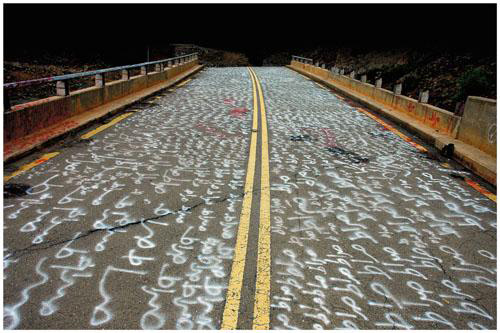
Abdulnasser Gharem
Siraat (The Path)
2009
Video
3 min. 4 sec.
Courtesy: Edge of Arabia
The other aspect to this is that many artists are making use in their works of existing archival materials. Those artists also appear to want to tell the world about their own experiences, but their work is different from those of journalism. Journalistic photographs must convey the facts, but for artists the conveyance of facts in itself is not as important as conveying those facts from one's own perspective. Thus you can read in the artworks the facts of specific incidents, but you can also see other elements, too.
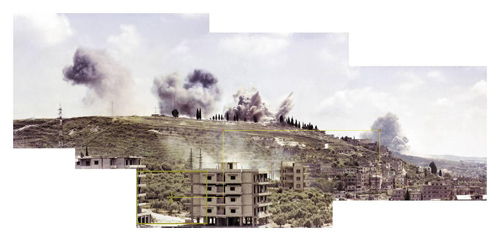
Akram Zaatari
Saida, June 6, 1982 - showing camera movements
2006-09
Composite image, C-print
112 x 210cm
Courtesy: Sfeir-Semler Gallery, Hamburg and Beirut
For example, in the collage Saida, June 6, 1982 - showing camera movements by Akram Zaatari (born, resides in Lebanon), you can see several explosions occurring simultaneously on a hill. Zaatari assembled the work from photographs that he took from his balcony when he was 16 years old, and I can only imagine how scary it must have been for such a young boy to see explosions like that from his own apartment.
This photographic work conveys to us the fear that he felt witnessing this event, but if you look at it closely you can also see that it contains the frame markings and time stamps of the original photographs. In fact, it turns out that these explosions did not occur at the same time at all. Zaatari has combined them into a single image at a later date.
There is naturally a general expectation among viewers that photographic media convey "facts," so when we see photographs of an event in the newspaper, for example, we immediately assume that such an event took place. Zaatari takes advantage of this presumption of "truthfulness," building in a small but significant conceit. Furthermore, media outlets tend to have a preference for shocking photographs when they are reporting a war, and I think his work also entails criticism of that approach.
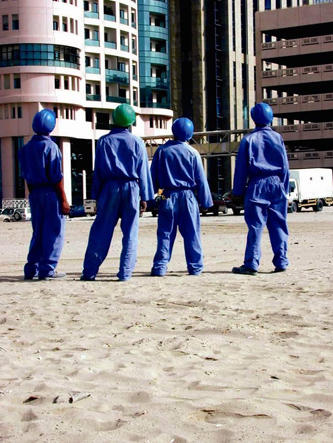
Mohammed Kazem
Window 2003-2005
2003-05
Digital print on light box (set of 14), engraved acrylic plate, video
Dimensions variable
- I heard there is a fountain in the exhibition?
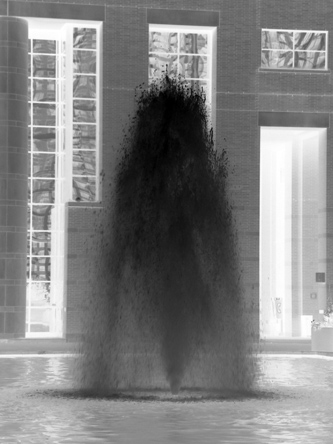
Maha Mustafa
Black Fountain
2008-
Mixed media installation
Dimensions variable
Installation view: "Black Fountain," Passagen Linköpings Konsthall, Sweden, 2009
Photo: Sara Ibrahim
Kondo: Yes, inside the Mori Art Museum galleries located on the 53rd floor, there is a fountain, some two meters high.
This is a work titled Black Fountain, by Maha Mustafa (born in Iraq; resides in Canada and Sweden).
On seeing the black water, we Japanese are likely to remember the "black rain" after the atomic bomb explosions over Hiroshima and Nagasaki. Mustafa's reference point is different. She actually experienced black rain in Iraq during the first Gulf War, when the oil fields were set on fire, so Black Fountain reflects a personal experience of her own.
And, of course, the sight of black liquid shooting up from the ground will also remind viewers of oil and the petroleum industry. Oil has been at the root of numerous conflicts, including the Gulf War, and so I think this work also contains a message to the effect that oil is a double-edged sword, capable of delivering great wealth but also great pain.
- About the Arab Lounge
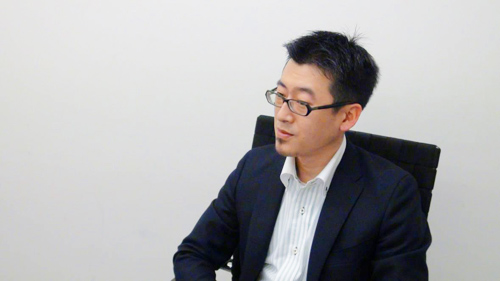
Kondo Kenichi (Associate Curator, Mori Art Museum)
Kondo: One of the objectives of the exhibition is to encourage greater interest in the Arab world, and to accommodate such interest we have created the "Arab Lounge." The books, videos and other information provided in the Lounge will help visitors understand the complex social context that exists behind each work.
We encourage you to spend whatever time you can to explore the many materials available.
■Relevant information
・Interview: Nanjo Fumio on "Arab Express"
Part 1 Comparing the Arab world of the 1970s with that of today
Part 2 Why is the world fascinated with Arab contemporary art?
Part 3 An exhibition to encourage cultural diplomacy, mutual understanding
・Interview: Kondo Kenichi on "Arab Express"
Part 1 Want to show Japan the diversity of the Arab world
Part 2 Exhibition highlights: Black Fountain and "Arab Lounge"
・"Arab in One Minute"
File-01 The Arab World on Screen
File-02 My first time at the cafe, the meeting place of men
File-03 Lamb or Chicken, That Is the Question / Cuisine and Hospitality
File-04 Ruins from Time Immemorial: Mesopotamia, the Birthplace of Civilization
File-05 The Beauty is in the Geometry:Calligraphy and Arabesque
"Arab Express: The Latest Art from the Arab World" introduces the work of about 30 artists from the Arabian Peninsula and surrounding Arab countries. This exhibition will bring you up to date with the latest developments from an art scene that is now the focus of international attention.
・Arab Express: The Latest Art from the Arab World
16 June - 28 October, 2012








